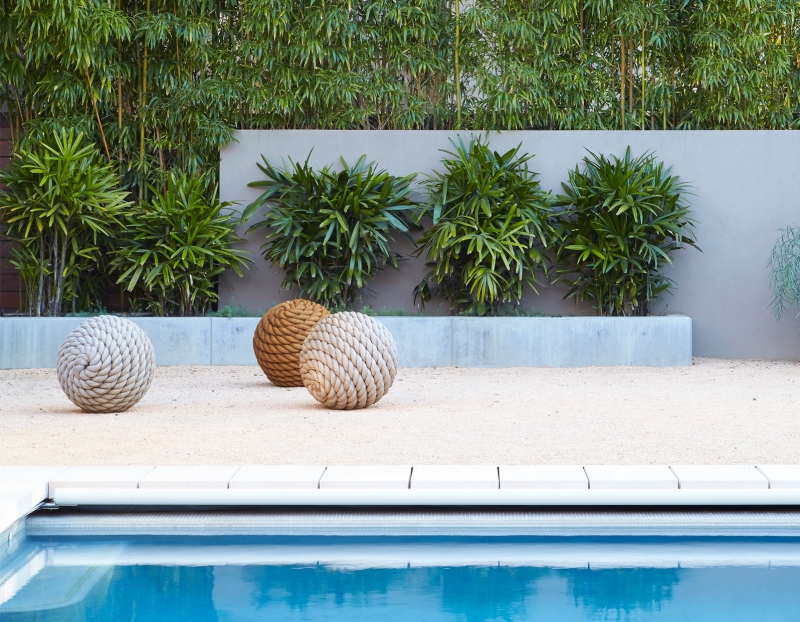Rhapis excelsa
lady palm
Lush, full bamboo-like growth makes excellent screen or backdrop. Good in containers. Excellent planted singly or in groups.

 |
height |
5–12ft |
 |
width |
6–10ft |
 |
tolerates |
Pots |
 |
water
needs |
Moderate |
 |
water
info |
This palm should be watered deeply every week or two once it’s established. It doesn’t want to ever dry out completely. |
 |
hardy
to |
25F |
 |
exposure |
Full Shade – Part Sun |
 |
indoor
outdoor |
Outdoor |
 |
drainage |
In Ground: Cactus Mix, In Pots: Cactus Mix, Tolerates Heavy Soil, Tolerates Sandy Soil |
 |
fertilizing |
Palm Fertilizer |
 |
origin |
S China |
 |
california
native |
No |
 |
sunset
zones |
12–H2 |
OUTDOOR EXPOSURE GUIDE

Full Sun
Six or more hours of sun beams directly landing on the plant's leaves.
Part Shade
Three to five hours of sun beams directly landing on the plant's leaves.
Part Sun
One to two hours of sun beams directly landing on the plants leaves.
Full Shade
The plant is never fully lit by sun beams,
but is in a bright spot or has dappled sunbeams playing over the leaves throughout the day.
Deep Shade
The plant never has dappled light on the leaves, and is in a place that feels dim, even on a nice sunny day.
SUNSET ZONES MAP

Growing Notes
Palms are generally heavy feeders, so if you want them growing quickly and looking their best, they should be fertilized at least three times a year. Fertilizing at spring equinox, summer solstice and fall equinox will allow for a winter rest. Be sure to feed your palm with a fertilizer that contains micronutrients (especially including magnesium), especially if you see yellowing leaves or yellow spots on the leaves.
Suckering palms like this one send out additional palm trunks from the base of the palm over time, so that you’ll end up with multiple trunks on one palm. If you want fewer trunks and a more open screen, go ahead and thin out the suckers; this is best done early on.
This palm naturally grows stems covered with a furry brown raffia. If desired, this can be easily removed to expose glossy apple green stems, similar to bamboo.
Tolerates dry desert heat, given shade.
Adaptable to various soil.
Special Interest
This palm is a staple plant in the subtropical Zen garden style, where it’s often complemented by conifers and grasses.
More Info
This plant was grown for an outdoor environment, so we do not recommend moving it inside. In general we do not recommend moving plants raised for an outdoor environment indoors.
This plant would make a good houseplant if it had been grown in a controlled greenhouse with houseplant soil. This ‘greenhousing’ ensures that plants who come home with you are well acclimated to indoor life, and also that they don’t have any pests. It is common for outdoor plants to have other passengers as well, such as earthworms or centipides that don’t necessarily hurt the plant, but aren’t welcome indoors.
If you consider yourself an expert gardener, you can of course attempt to transition this plant indoors. In that case you’ll want to strip all the soil from the rootball, wash the roots clean and then spray the entire plant (leaves, undersides of the leaves, all the cracks and roots) with a mix of one tablespoon of rubbing alcohol in a cup of water. Repot the plant in the appropriate sterile soil/pot and take extra care as it transitions to the indoors, especially looking for pests and treating at the first sign of problems. Always consider the risk that any bugs could also affect other houseplants you have nearby.
For some plants, we sell two versions: outdoor-grown and greenhouse-grown. If you’re looking to grow this plant indoors, feel free to ask our staff if we have a greenhouse-grown version in stock.


